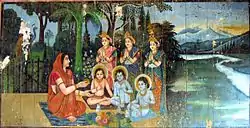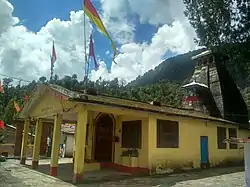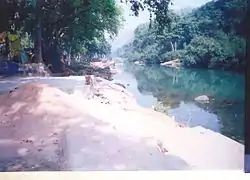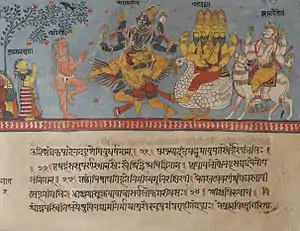Anasuya
Anasuya (IAST: Anasūyā, अनसूया "free from envy and jealousy"), also known as Anusuya, was the wife of an ancient rishi (sage) named Atri and daughter of Prasuti and Daksha in the Hindu epics. In the Ramayana, she lived with her husband in a small hermitage on the southern border of the Chitrakuta forest. A pious woman who always practiced austerity and devotion, she is described as having miraculous powers.[1]
| Anasuya | |
|---|---|
 | |
| In-universe information | |
| Family | Prasuti Daksha |
| Spouse | Atri |
| Children | Dattatreya Chandra Durvasa Shubatreyi |
Her mother was Devahuti and her father was sage Kardama, Sage Kapila was her brother and teacher. She is extolled as Sati Anusuya – Anusuya, the chaste wife of sage Atri. She later became the mother of Dattatreya, the sage-avatar of Vishnu and Durvasa, the irascible sage. When Sita and Rama visited her during their exile, Anusuya was very attentive to them, giving Sita an ointment which could maintain her beauty forever.[2]
Etymology
Anasuya is composed of two Sanskrit words: Nah and Asuya. Nah' is a negative prefix which means absence, while Asuya means jealousy. Anasuya could be translated into English as the one who is free from jealousy or envy.[3]
Stories of Anasuya and Atri
The story of Anasuya's family is mentioned in Bhagavata Purana Skanda III. Sage Kardama married Devahuti, daughter of Swayambhu Manu. They had ten children, a son named Kapila Maharshi (Lord Vishnu's avatar) and nine daughters including Anasuya. As each daughter was married to a rishi, Anasuya was married to Athri Maharshi.[4]
The Divine Trinity tests Anasuya

Sage Narada praised Anasuya in his hymns and verses, by which Laxmi, Parvati and Saraswati wanted to learn pativratya from Anasuya. They requested their husbands go ask her permission so that they could visit her in human form. The Divine Trinity went to Anasuya disguised as sages and asked permission for their wives in the form of bhiksha, on the condition that she would be naked while serving them.
At first she was perplexed, but ultimately she understood who they were thanks to her yogic powers. She turned them into 6-month-old babies and removed her clothes to feed them with motherly affection. Many days passed as the three goddesses waited for their husbands to return. When the husbands did not return, they traveled to Anasuya's cottage and found them transformed into children. The Goddesses requested Anasuya to bring them back to normal.
According to a popular version, the Holy Trinity was pleased with her chastity and devotion towards her husband, who then granted her a boon. She asked the Holy Trinity to be incarnated as her children, three sons and a daughter named Shubhatreyi. Another version relays a different result in which the gods merged and turned into Anasuya's three-headed son.
A Brahmin named Kaushik from Pratishthan used to visit a prostitute, despite being a Brahmin and having a devoted wife. When he later became infected with leprosy, the prostitute stopped seeing him, forcing him to return to his wife who still cared for him. He still longed for the affection of the prostitute, so one day, he asked his wife to take him to her.
In that town, sage Mandavya had been impaled in lieu of a crime and was lying on a spike in the forest. While being led by his wife through the deep forest at night, Kaushik happened to trip on the sage, who cursed him to death before the next sunrise. To stop the curse, Kaushik's wife stopped the sunrise with the power of her love, creating havoc in the heavens. The gods went to Brahma for help, who in turn went to Anasuya, asking her to convince Kaushik's wife to allow the sunrise.
Anasuya not only convinced Kaushik's wife to allow the sun to rise but also brought Kaushik back to life after the curse had run its course. Brahma was very happy with Anusuya and was then born to her as Chandraatri.
Sometime later, Rahu masked the sun, cloaking the whole world in darkness. With powers granted by many years of austerity, Atri wrested the sun out of Rahu's hands, restoring light to the world and pleasing the gods.
Sati Anusuya Ashrama

Anusuya Devi Temple is in Uttarakhand, located further upstream on the Amrit Ganga- a tributary of Alakananda/Ganga.

Sati Anusuya Ashram is in Chitrakoot, Madhya Pradesh, located further upstream on the Mandakini River. It is 16 km away from the town, and set amidst thick forests where the melody of birdsong plays all day. It was where sage Atri, his wife Anusuya, and their three sons (who were three incarnations of Brahma, Vishnu and Shiva), lived and are said to have meditated.[5]
Valmiki describes in the Ramayana that there once was no rain in Chitrakuta for ten years. There was a severe famine and nothing was left for animals and birds to eat or drink. Sati Anusuya performed intensive austerities and got the river Mandakini down on earth. This led to the growth of greenery and forests, and eliminated the suffering of all sages and animals.[6]
Sati Anasuya Ashrama, at present, is a very peaceful place where several streams from the hills converge and form the Mandakini River. It is said that Rama along with Sita had visited this place to meet Maharishi Atri and Sati Anasuya. It was here that Sati Anasuya explained to Sita the grandeur and importance of satitva. The dense forests of Dandaka start from this place. It was ruled by Ravana, who had appointed strong rakshasas such as Khara and Viradha as its rulers. The place was infected by the terror of rakshasas.[7]
Popular culture
The story of Anasuya has been adapted for film in India. Mahasati Ansuya is a 1943 Hindi film made in 1943 by V.M. Vyas, starring Shahu Modak, Durga Khote and Shobhna Samarth.
Two movies in the Telugu language, both entitled Sati Anasuya were released in 1957 and 1971. The 1957 film was directed by Kadaru Nagabhushanam[8] and starred Anjali Devi and Gummadi Venkateswara Rao. The 1971 film was directed by B. A. Subba Rao.[9] Jamuna Ramanarao played the role of Anasuya, Sharada played Sumati and Tadepalli Lakshmi Kanta Rao played Atri Maharshi. The musical score was provided by P. Adinarayana Rao.
The adaptation was also made in the Kannada language in 1966 wherein Pandari Bai played Anasuya, K S Ashwath was Atri, and Dr Rajkumar played the role of Narada Muni. He would be instrumental in bringing down the false pride of the wives of Trimurti. To test Anasuya, the Trimurti approached her for food. They appeared as unclothed sages with a condition. Anasuya transforms the Trimurti into toddlers, puts them in cradles, and feeds them. All the while, she sings to them, 'Aaadi deva aadi moola aadi bramha jo jo.' Atri also joins her.
References
- "Sati Anasuya". www.speakingtree.in. Retrieved 20 May 2020.
- Gopal, Madan (1990). K.S. Gautam (ed.). India through the ages. Publication Division, Ministry of Information and Broadcasting, Government of India. p. 66.
- "Sati Anasuya". Retrieved 20 May 2020.
- Purnendu Narayana Sinha (1950). A Study of the Bhagavata Purana: Or, Esoteric Hinduism. Library of Alexandria. pp. 96–. ISBN 978-1-4655-2506-2.
- "Incredible India | Sati Anusuya Ashram". www.incredibleindia.org. Retrieved 20 May 2020.
- Ramayana, Ayodhya Kanda – Sarga 117 shloka 9, 10.
- Ramayana, Ayodhya Kanda – Sarga 116 shloka 11, 12.
- Sati Ansuya (1957). IMDb
- Sati Ansuya (1971). IMDb
- A Dictionary of Hindu Mythology & Religion by John Dowson

